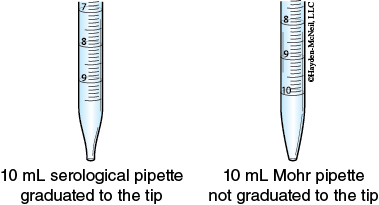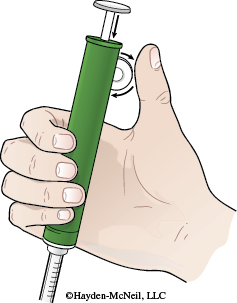Chapter 2. Laboratory Techniques
Learning Objectives
General Purpose
Conceptual
- Be able to compare and contrast the different types of pipettes.
Procedural
- Be able to accurately measure and transfer small volumes of liquids using the appropriate pipettes.
General Purpose
This lab will help familiarize you with some of the techniques you will be using in the exercises throughout this manual. It will also introduce you to some of the basic equipment needed to conduct the exercises in the manual.
General Background Information
Conducting experiments in biology requires the use of certain specialized equipment and techniques. To perform these techniques and use this equipment accurately and efficiently it is important to understand how the equipment works and to become practiced in the techniques. One of these techniques is pipetting. The pipetting techniques you are going to use during this exercise will be used during many of the other laboratory exercises this semester, and you may use them in other courses in the future. These techniques are also used in a wide variety of fields from industry to health care.
Pipettes and Pipetting
During many of the laboratory exercises that you will conduct this semester you will measure and transfer small volumes (10 mL or less) of liquids. This is commonly done using a pipette. Pipettes have many forms but all are designed to accurately measure and transfer small volumes. There are several different types and sizes of pipettes, which are used for slightly different purposes. Be sure that you know how to identify the different types of pipettes and that you can determine the total volume and, where applicable, the gradations on each.
Types of Pipettes
Mechanical Pipettes
Mechanical pipettes, or micropipettes, are used for very small volume transfers (i.e., less than 1 mL) where a high degree of precision is required.

Micropipettes come in several size ranges. Depending on the size, different color-coded disposable tips are used. The three most common size ranges are 100 to 1000 μL (0.1 mL to 1 mL), which take blue tips, and 10 to 100 μL (0.01 mL to 0.1 mL) and 1 to 20 μL (0.001 mL to 0.02 mL), both of which take yellow tips. This semester you will be using the 10 to 100 μL size. The volume to be transferred is set by turning the volume adjustment rings. A disposable tip fits on the end of the pipette. By depressing the plunger to the first stop point and placing the tip in the liquid and slowly releasing the plunger, the exact amount to be transferred can be drawn up into the tip. To expel this volume, depress the plunger to the second stop point. In some cases, micropipettes are fitted with a tip ejector to remove the tip.
Volumetric Pipettes
Volumetric, or transfer, pipettes are designed to deliver a single volume precisely (the volume will be indicated near the top of the pipette (i.e., 5 mL). These pipettes do not have gradation markings and only have a single mark or engraved ring above the bulb in the pipette indicating the volume the pipette is designed to contain.

Fluid must be drawn up in the pipette to above the mark or engraved ring and then released slowly until the bottom of the meniscus of the liquid is exactly at the engraved ring or mark (the tip of the pipette should be touching the wall of the sample vessel as fluid is released). To transfer this volume to a second container, touch the pipette tip to the inside wall of the new container and allow the liquid to drain out.
Graduated Pipettes
There are two general types of graduated pipettes: Mohr and serological. Each of these types comes in various sizes which are used for various volumes. You should try to use the pipette that is just big enough for the volume you are going to transfer. For example, if the volume you need to transfer is 1.5 mL, the best pipette to accomplish this with the highest accuracy would be a 2 mL pipette (not a 1 mL or a 5 mL or larger).
Mohr pipettes are designed to transfer a volume by moving the meniscus of the liquid between two gradation marks on the pipette. The gradation markings on the Mohr pipette do not go all the way to the tip of the pipette but stop before the pipette begins to narrow (see Figure 1-3).

To accurately transfer fluid with a Mohr pipette, the meniscus must be precisely on a calibration mark both at the beginning and at the end of a transfer. Near the top of this type of pipette you will find the total volume indicated and the size of the smallest gradations (i.e., 10 mL in 1/10, the total volume of the pipette is 10 mL and it is graduated in 1/10 mL increments). The marking near the tip of the pipette should be the same as the total volume listed near the top of the Mohr pipette.
Serological pipettes are graduated to deliver (there is no base mark). The appropriate amount of fluid is drawn into the pipette (with the meniscus precisely on the correct mark) and the entire amount is transferred. Since serological pipettes are labeled with the zero mark at the top of the pipette, you will need to subtract the amount you are going to pipette from the total volume of the pipette to determine the exact mark to fill the pipette to. For example, if you are going to pipette 6.5 mL using a 10 mL pipette you would fill the pipette to the 3.5 mL mark. To determine the total volume of the pipette, look near the top of this type of pipette. There you will find the total volume indicated and the size of the smallest gradations. There are two types of serological pipettes. Those with a single painted or frosted ring at the top should be allowed to simply drain with the tip placed against the side of the receiving vessel. Those with double rings are designed to be “blown out” by pushing a small amount of air out of the pipette, completely emptying it.

A pi-pump is a device designed to safely and easily draw fluid up into a pipette. Since not all pipettes have the same size diameter, there are two different sizes of pi-pumps made to fit the various sizes of pipettes: blue for pipettes up to 2 mL and green for 5 or 50 mL pipettes. The pi-pump has a neoprene gasket with a hole in it designed to fit over the top end of a pipette. The pi-pump has a neoprene gasket with a hole in it designed to fit over the top end of a pipette. To draw up fluid into the pipette, operate the wheel control on the pi-pump. To expel the fluid from the pipette you can either depress the plunger on the top of the pi-pump or for more control rotate the wheel control in the opposite direction.
Pre-Lab Quiz
Proceed to the Pre-Lab Quiz